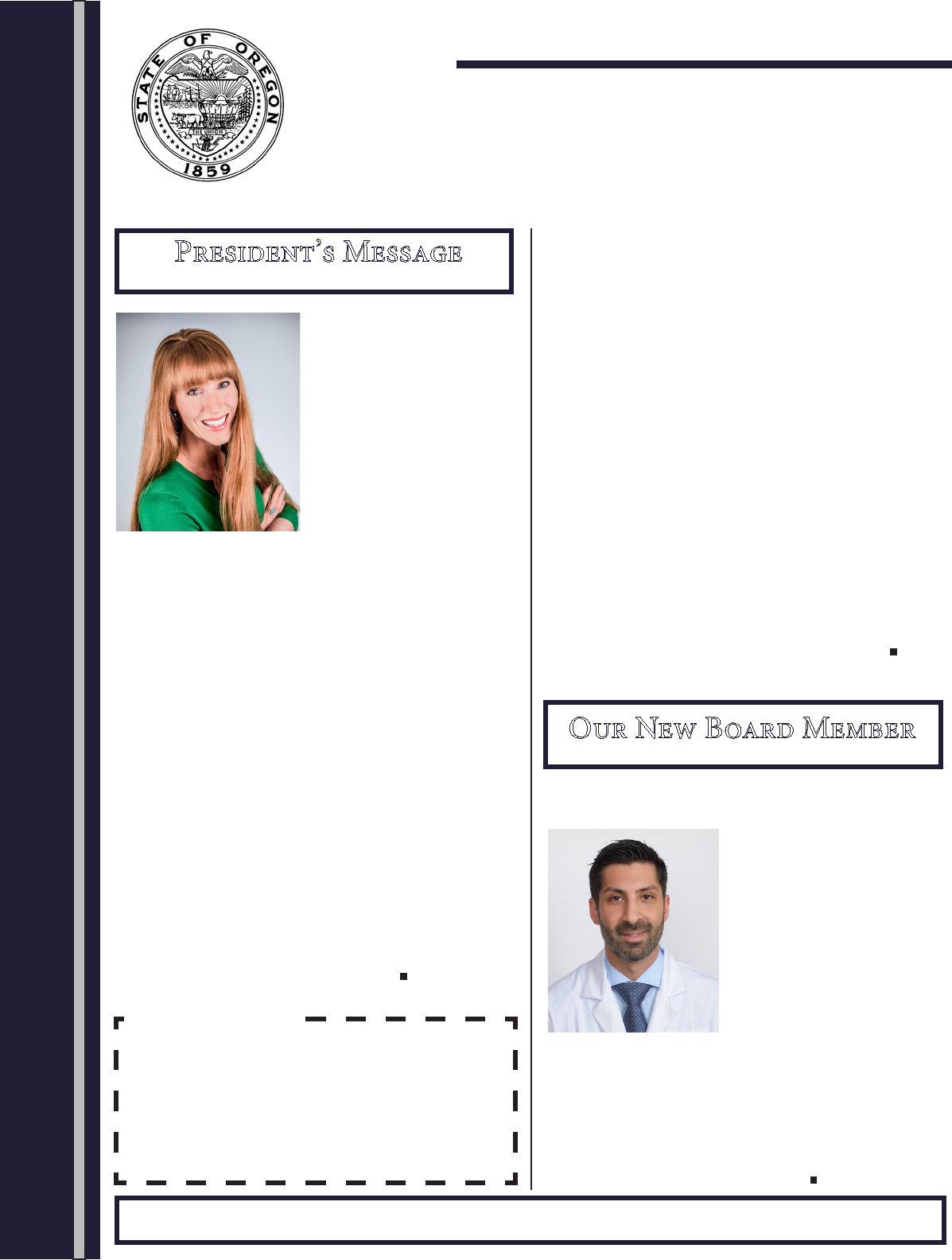
T
he Governor appointed and the Senate conrmed Dr. Reza J. Shar-
i as our newest Board Member on May 15. He replaces Dr. Julie
Ann Smith. Dr. Shari’s term of service
is May 15, 2019 through May 14, 2023.
OBD Sta welcomed him with a new
board member orientation on June 7
with assigned assistant attorney gen-
eral Lori Lindley participating as well.
Reza J. Shari, DMD, FACS, Diplo-
mate of the American Board of Oral
and Maxillofacial Surgeons was born
and raised in Portland, Oregon. He re-
ceived his undergraduate degree from
Portland State University and his Doc-
tor of Dental Medicine degree from
Boston University School of Dental Medicine. He then completed his
Oral Surgery residency at Tripler Army Medical Center in Honolulu,
Hawaii. He was stationed at Fort Gordon, Georgia as the Assistant
Program Director at Dwight D. Eisenhower Army Medical Center Oral
Surgery Residency program. Aer nine years of serving in the United
States Army, he decided to return home to Portland. He was honored
with numerous awards while serving the military and has extensive ex-
periences of lecturing to his dental colleagues.
W
ith the leaves changing vi-
brant colors and a chill in
the air, autumn is moving into full
swing. With the season change, I
recognize what a natural time it is
for us to pause and reect on 2019.
Every year has its ups and down with
dierent challenges and joys. What
stands out about 2019 for you? As
I recall 2019, I focus on gratitude. I
have gratitude as I think about my
personal life, the profession of den-
tistry in Oregon, and for the role of
the Oregon Board of Dentistry.
What in your personal life are you thankful for? I am blessed with
amazing family and friends that I cherish. is past weekend, I had the
joy of strolling through the farmer’s market and playing in the leaves
with my children and husband. e vibrant leaves and nature’s beauty
ignited joy in my soul. I have immense gratitude for my colleagues and
work family that care for our community.
In addition, I appreciate the professional level of presence of dentist-
ry in Oregon. We are blessed with quality dental education programs
in our state- a dental school (Oregon Health and Science University
School of Dentistry) and numerous dental hygiene and dental assistant
education programs. Not all states are so lucky. I am lled with grati-
tude for the work that the Oregon Dental Association proactively does
to support dental professionals through many avenues. Personally, I am
honored that patients choose me to work with them in their oral health
journey.
Finally, I am grateful for the Oregon Board of Dentistry. Even though
there have been challenges at times, I am honored to be a member of
the board. e Oregon Board of Dentistry is the second oldest licens-
ing board in the state of Oregon created by an act of legislature in 1887.
e board is a group of our professional peers and public members
appointed by the Governor, who volunteer their time, to set standards
regarding education, examinations, and licensure.
O M: e mission of the Oregon Board of Dentistry is to promote high quality oral health care in the State of Oregon by equitably
regulating dental professionals.
News
OregON BOard Of deNtistry
Vol. 34, No. 1 December 2019
P’ M
In addition, they investigate complaints under the guidance of the
Dental Practice Act and Rules of the Board. ey are to also provide
clear interpretation of statutes and rules to licensees and the public.
e mission of the Oregon Board of Dentistry is to promote high qual-
ity oral health care in the state of Oregon by equitably regulating dental
professionals. While some decisions are made by the Oregon Board of
Dentistry, it is also important for licensees to understand that at times,
there are decisions made at the legislative level that are then passed
onto the Board of Dentistry to create rules to enforce.
In addition to the board members, the Oregon Board of Dentistry has
phenomenal sta members that work hard to meet the organization's
needs. I am thankful for their diligence and wealth of knowledge. I also
have immense gratitude for previous work done at the board.
Oregon distinctly stands out in the nation for how we have recognized
our hygienists’ abilities and expanded their scope. Most of all, I am
thankful that the dental profession in Oregon has its own regulatory
board that understands the challenges and nuances of our industry and
has dental professionals actively involved.
As you pause and reect on 2019, the challenges and joys, I hope you
nd space to count your blessings and have gratitude for what you have
personally and professionally. I encourage you to explore how you too
might be involved in supporting and advancing dentistry in Oregon.
Wishing you a joyous holiday season and phenomenal 2020.
Amy B. Fine, D.M.D.
O N B M
Reza J. Shari, D.M.D.
What’s Inside
Message from the Executive Director ............................................ 2
New Sta Introductions ................................................................... 3
New Vaccine Bill ............................................................................... 4
Cultural Competency CE ................................................................ 5
Rule Changes Eective 1/1/2020 .................................................... 7
Hot Topics ......................................................................................... 9
Opioid Abuse & Prescribing Guidelines ....................................... 10
Frequently Asked Questions ........................................................... 11
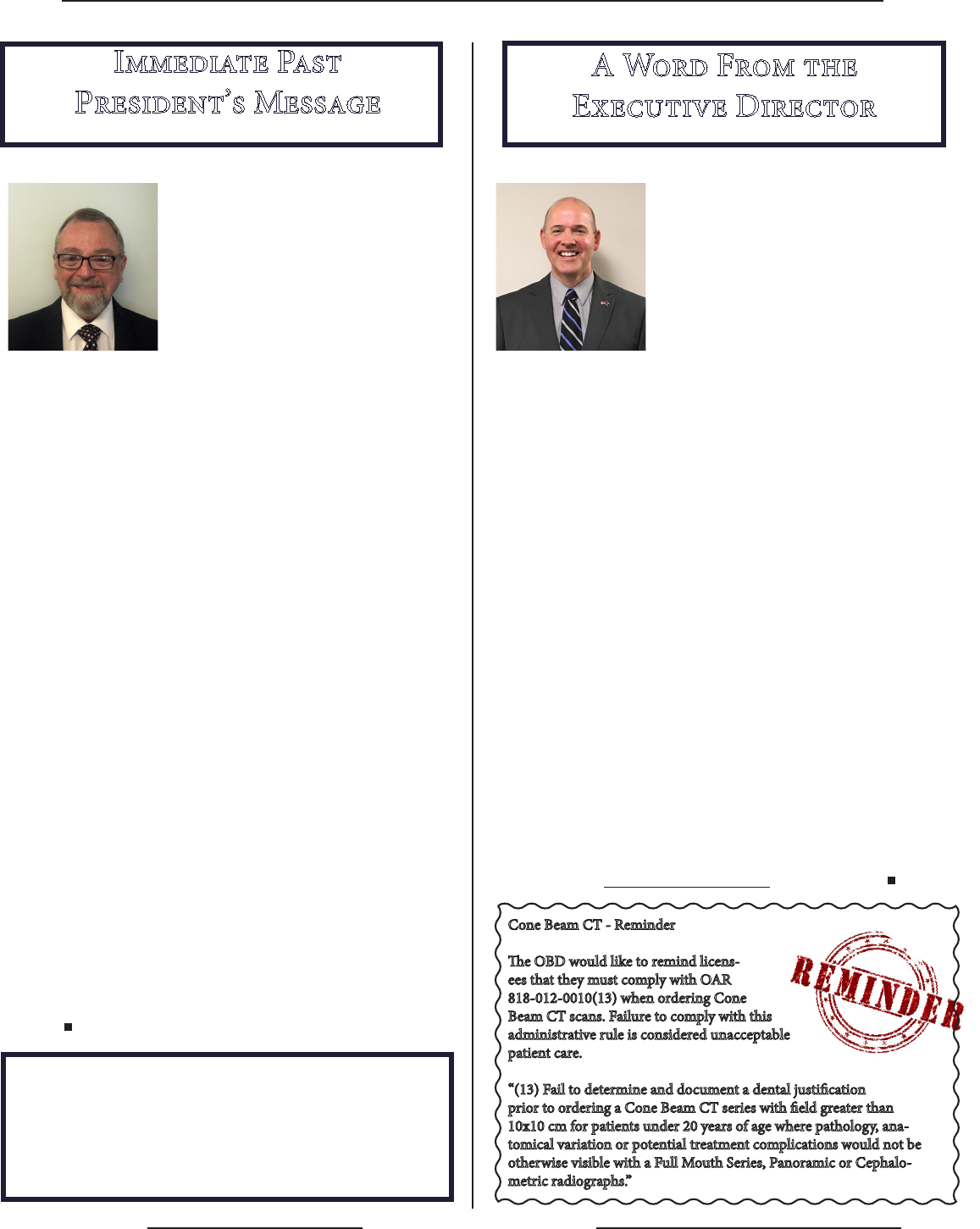
OREGON BOARD OF DENTISTRY
December 2019
I P
P’ M
Gary Underhill, D.M.D.
A W F
E D
B
revity, Equity, Fairness, Focus, and
Courtesy - these words are on my desk,
and are what I strive for every day at the Ore-
gon Board of Dentistry (OBD). I will keep my
article brief and to the point, as there are many
other articles which will highlight important in-
formation that we feel you should be aware of in
this Newsletter.
In 2019 we said thank-you and farewell to Dr.
Julie Ann Smith aer eight years of service from 2011 – 2019 as a Board
Member. She served as OBD President, Chair of the Anesthesia Commit-
tee, chaired other workgroups and committees, and helped shape the OBD’s
2017-2020 Strategic Plan. We are all fortunate that the Board attracts people
with her professional acumen, respect for the profession, level of engage-
ment and professional courtesy.
e Governor appointed and the Senate conrmed Dr. Reza J. Shari as our
newest Board Member on May 15, 2019. He replaced Dr. Julie Ann Smith
on the Board. Dr. Shari’s term of service is May 15, 2019 through May 14,
2023. We also welcomed a new dental investigator, Dr. Winthrop "Bernie"
Carter, who you will learn about later in this newsletter.
Stephen Prisby
2
e 2019 Legislative session concluded with new pieces of legislation that
aect our Licensees and all state agencies. New laws and OBD Committee
work have funneled a variety of rules to our Board and to public rulemak-
ing hearings. We encouraged feedback and input from the dental commu-
nity on proposed rule changes. Please see the article later in this newsletter
for more information on these 34 rule changes, which are eective January
1, 2020.
Once again, the only piece of legislation that came from the OBD was our
budget bill, HB 5013. Also once again, I am happy to report that there are
no fee increases of any type for 2020. We managed our budget well, and
have an adequate surplus at the start of the 2019 - 2021 Biennium.
Another year is wrapping up, and I wish you all happy holidays and a great
start to 2020. If you have any questions or comments, I look forward to
hearing from you. Stephen.Prisby@ state.or.us or 971-673-3200.
Cone Beam CT - Reminder
e OBD would like to remind licens-
ees that they must comply with OAR
818-012-0010(13) when ordering Cone
Beam CT scans. Failure to comply with this
administrative rule is considered unacceptable
patient care.
“(13) Fail to determine and document a dental justication
prior to ordering a Cone Beam CT series with eld greater than
10x10 cm for patients under 20 years of age where pathology, ana-
tomical variation or potential treatment complications would not be
otherwise visible with a Full Mouth Series, Panoramic or Cephalo-
metric radiographs.”
A
utumn has arrived! It is my favorite time
of year! Temperatures are cooling, the air is
clean and the trees are turning beautiful shades
of red and yellow. It is also time to head out to
eld and stream to enjoy some of our best out-
door activities.
I recently spent three days in the eld with two
of my colleagues from the OBD to enjoy some
central Oregon outdoor activities. As I did so, I
was once again reminded how fortunate I have been to be part of our health
care community.
We all start this journey in Dental School or Dental Hygiene School. For
some of us this was a fun time, but for others it was not. However, friends
and contacts are made which we carry forward. When our class graduated
in 1972 the majority of us went into the military for a variety of reasons. e
Vietnam conict was on hot and heavy, so most of us joined our Freshman
year to keep from getting draed. We then entered active duty upon grad-
uation. My wife and I were sent to Fort Rucker Alabama. At that time there
were 29 dentists on post with a very active Dental Society. Once again, we
met people who are still friends today.
Aer arriving in Enterprise Oregon, it wasn't two weeks before the Presi-
dent of the Eastern Oregon Dental Society came over and took me to lunch.
Dr. Dennis Turner and other members of our local dental community be-
came some of our closest friends. Early on, a senior member of our den-
tal society was instrumental in calming down an angry patient of mine.
He sent neither the patient nor myself a bill. I have seen my colleagues go
through nancial problems, divorce, and loss of family with major support
coming from their colleagues.
I have now been on the OBD for ve years, and it has become like family
to me. During this time, many cases have come before the Board. On occa-
sion, it is obvious that the Licensee needs help. It is nice to have resources
available where people can receive the help they need. e ODA was very
helpful recently in such a circumstance.
I am now in the twilight of my career, and as I look back I realize what
a blessing it has been to be part of this profession. I would encourage all
of you, especially the younger members to get involved. You can join the
dental or dental hygiene association. You can be a part of a study club or
volunteer to serve on the OBD or an OHA Committee. roughout the
state there are many advocacy groups and boards that need healthcare vol-
unteers with your expertise & experience. ere are many opportunities
for service, and I promise you, the rewards will be greater than you can
imagine!
www.oregon.gov/dentistry
Would you like to receive publications from the Board, such as
Notices of Proposed Rulemaking and Agendas for Board and
Committee meetings?
Manage your subscriptions on the OBD website.
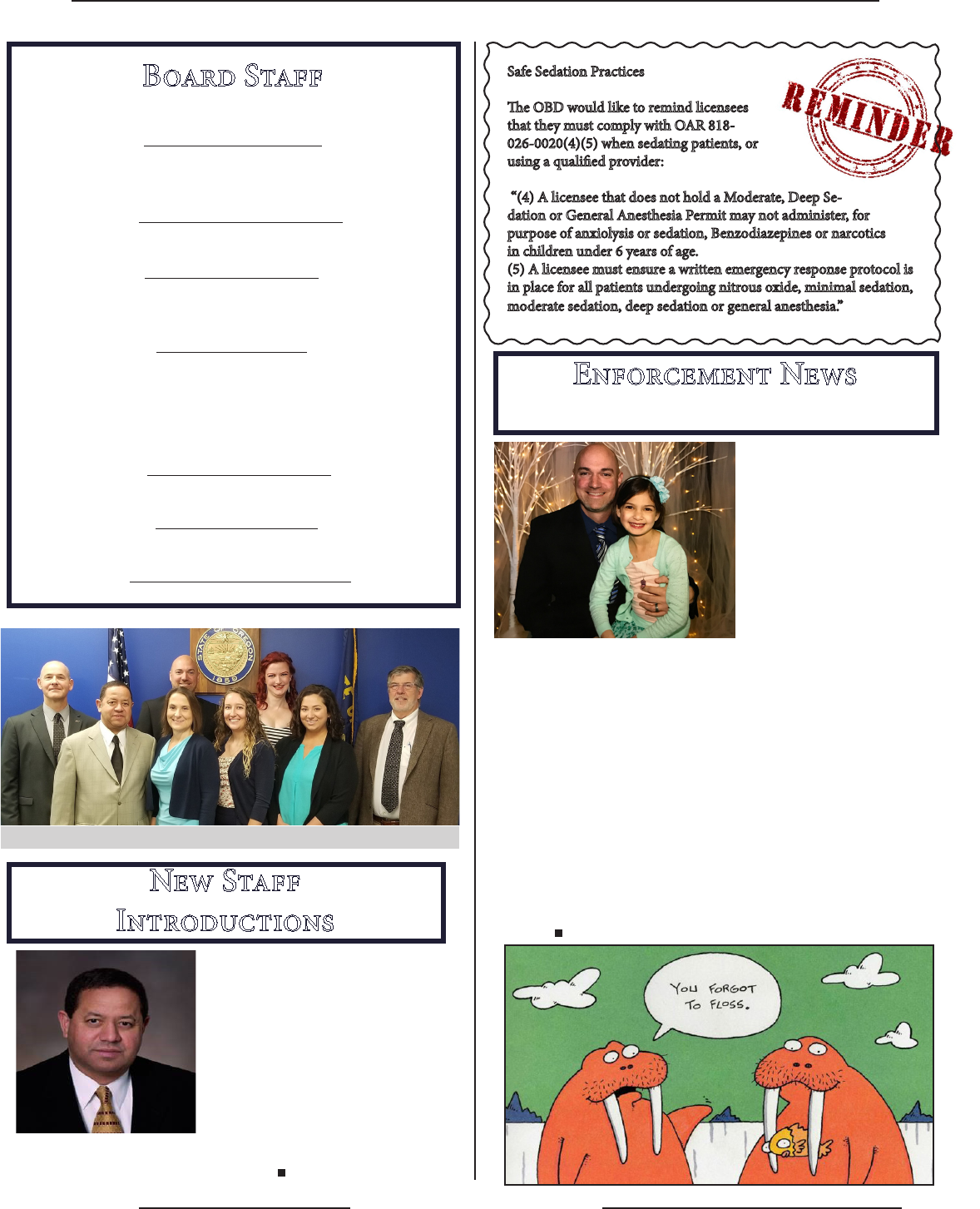
OREGON BOARD OF DENTISTRY
December 2019
www.oregon.gov/dentistry
3
N S
I
B S
Stephen Prisby,
Executive Director
Stephen.Prisby@state.or.us
Daniel Blickensta, D.D.S., M.Sc.,
Dental Director and Chief Investigator
Daniel.Blickensta@state.or.us
Teresa Haynes,
Oce Manager
Teresa.Ha[email protected]r.us
Ingrid Nye,
Examination and
Licensing Manager
Ingrid.Nye@state.or.us
Winthrop "Bernie" Carter, D.D.S.
Dental Investigator
Haley Robinson,
Investigator/Diversion
Coordinator
Haley.Robinson@state.or.us
Shane Rubio,
Investigator
Shane.Rubio@state.or.us
Samantha VandeBerg,
Oce Specialist
Samantha.VandeBerg@state.or.us
W
e welcomed Dr. Winthrop (Bernie)
Carter as our new dental investiga-
tor on February 1, 2019. Dr. Carter comes
to the OBD aer completing 15 years at the
OHSU School of Dentistry. Dr. Carter also
chaired the OHSU Department of Peri-
odontology for over nine years. A total of
47 periodontal residents have been trained
by Dr. Carter. Dr. Carter also completed
over 20 years of active duty with the US
Navy prior to arriving in Portland in 2002.
Dr. Carter has practiced General Dentistry for 14 years, Periodontics for
30 years, and Implant surgery for 25 years.
From Le to Right: Stephen Prisby, Dr. Bernie Carter, Shane Rubio, Teresa Haynes, Haley Robinson, Ingrid Nye,
Samantha VandeBerg, and Dr. Daniel Blickensta.
Safe Sedation Practices
e OBD would like to remind licensees
that they must comply with OAR 818-
026-0020(4)(5) when sedating patients, or
using a qualied provider:
“(4) A licensee that does not hold a Moderate, Deep Se-
dation or General Anesthesia Permit may not administer, for
purpose of anxiolysis or sedation, Benzodiazepines or narcotics
in children under 6 years of age.
(5) A licensee must ensure a written emergency response protocol is
in place for all patients undergoing nitrous oxide, minimal sedation,
moderate sedation, deep sedation or general anesthesia.”
E N
Shane Rubio,
Investigator
I
am the intake investigator for
the Board, and in most cases,
the rst person you will have
contact with should an issue
arise. If a complaint is led, you
as the Licensee will receive a let-
ter from me with a summary of
the complaint, a request for the
patient chart with radiographs,
continuing education comple-
tion certications for a specic
licensure period, proof of a val-
id Healthcare Provider BLS/CPR certication, sterilization records and a
written narrative about the allegation. For many licensees, a complaint can
be a stressful event. I understand this, and I make every attempt to make
myself available should questions or concerns arise.
During the latest renewal cycle, a common issue that has come up is the
maintaining of a Healthcare Provider BLS/CPR certication. Please be
aware that if you hold an active license (practicing or not), it is required that
you keep a valid certication at all times. Please review the rule below which
can also be found in the Dental Practice Act:
To sum up OAR 818-012-0030(18)- all Licensees must maintain at a min-
imum, a valid Healthcare Provider BLS/CPR certication while holding an
active license. Any lapse in certication (even if not currently practicing)
could lead to a Board investigation and possible action against the
Licensee.
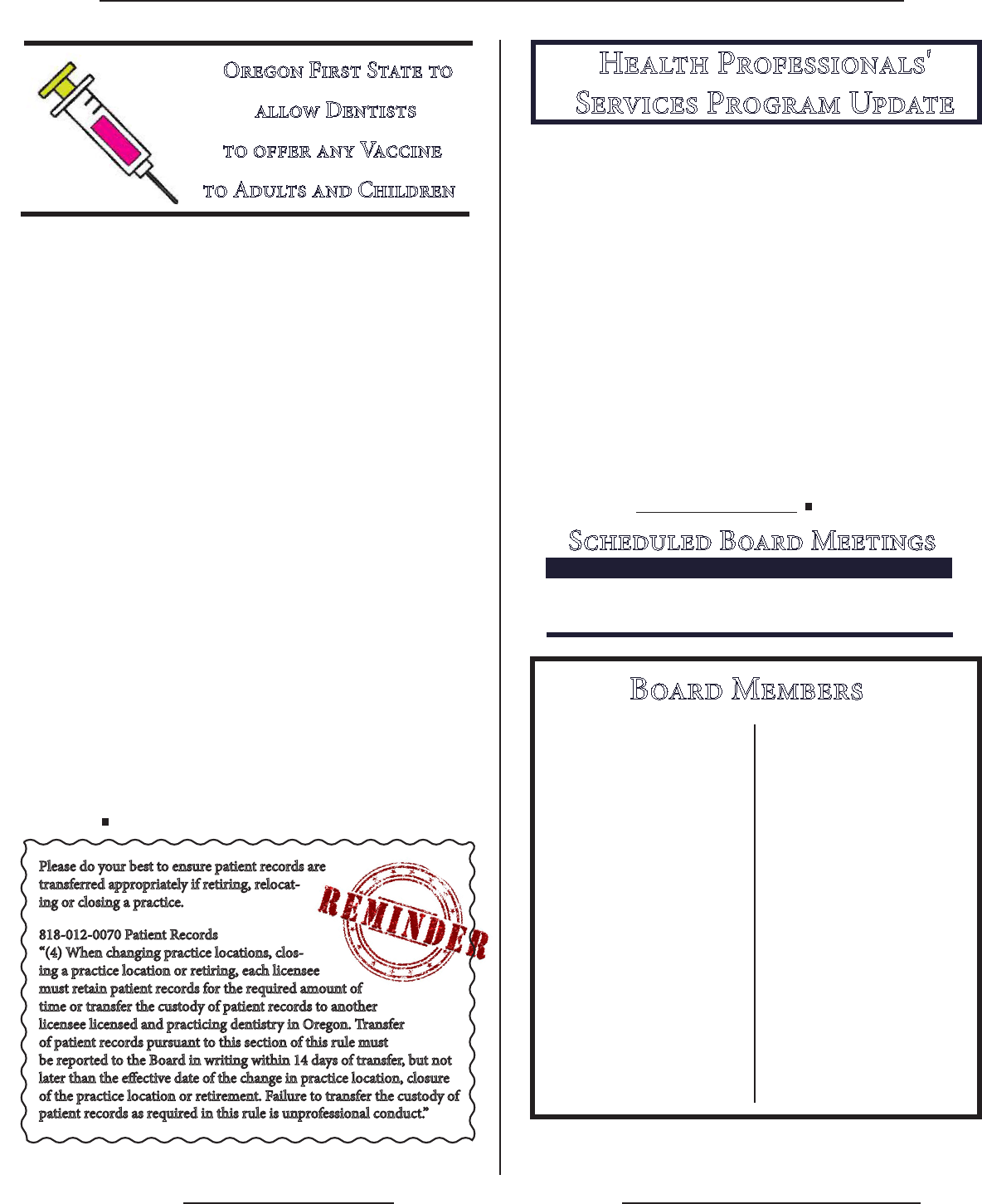
OREGON BOARD OF DENTISTRY
December 2019 www.oregon.gov/dentistry
O
regon’s Health Professionals’ Services Program (HPSP) is beginning
its tenth year of operation. e state’s HPSP began July 2010 follow-
ing the legislative consolidation of professional health boards' alternative to
discipline and diversion monitoring programs under ORS 676.190 and has
been operated by Reliant Behavioral Health ever since. e program sup-
ports public safety while helping licensed health professionals with recov-
ery and to continue practicing. To be eligible for the program, the licensed
health professional must have a diagnosed substance use disorder, a mental
health disorder, or both types of disorders. Four health profession regulato-
ry boards currently participate in HPSP: Oregon Board of Dentistry (OBD),
Oregon Medical Board (OMB), Oregon State Board of Nursing (OSBN),
and Board of Pharmacy (OBOP).
HPSP provides the structure and accountability for licensed health profes-
sionals to be successful. Licensed dental board professionals require approv-
al from the Oregon Board of Dentistry to participate in HPSP. e Board’s
designated Diversion Coordinator is Haley Robinson and she can be reached
at 971-673-3200. If you have any questions or concerns regarding HPSP, feel
free to contact Ms. Robinson. She can speak with you anonymously about
the program and the enrollment process. You can also learn more about
HPSP by visiting www.RBHMonitoring.com.
H P'
S P U
B M
Jose Javier, D.D.S.
Portland
First term expires 2020
Hai Pham, D.M.D.
Hillsboro
First term expires 2021
Alicia Riedman, R.D.H.
Eugene
Second term expires 2021
Gary Underhill, D.M.D.
Enterprise
Second term expires 2022
Charles “Chip” Dunn
Happy Valley
First term expires 2021
Amy B. Fine, D.M.D.
President
Medford
Second term expires 2022
Jennifer Brixey
Portland
First term expires 2020
Reza Shari, D.M.D.
Portland
First term expires 2023
Todd Beck, D.M.D.
Portland
Second term expires 2021
Yadira Martinez, R.D.H.
Vice President
Hillsboro
Second term expires 2022
S B M
2020
• February 21, 2020
• April 24, 2020
• June 19, 2020
• August 21, 2020
• October 23, 2020
• December 18, 2020
4
O F S
D
V
A C
O
regon is the rst state to allow dentists to oer any vaccination to pa-
tients of any age. On May 6, 2019, Governor Kate Brown signed into
law Oregon House Bill 2220, which enables dentists to prescribe and ad-
minister vaccines. Just two other states – Minnesota and Illinois – allow
dentists to administer vaccines, but only to protect against the u and only
in adult patients.
At its October 25, 2019 Board meeting, the OBD approved rules and pro-
cedures for the new law’s implementation. Two new Oregon Administrative
Rules: 818-012-0006 & 818-012-0007, which are eective January 1, 2020,
go into the details and specics about the training required before a dentist
may administer any vaccine.
e OBD brought together representatives from the Oregon Health Author-
ity (OHA), Oregon Dental Association (ODA), Oregon Health and Science
University (OHSU) School of Dentistry and the Oregon Board of Pharma-
cy (OBP) to dra rules for the Board to consider. ese dra rules went
through the public rulemaking process, and were further ne-tuned before
being approved.
OHSU School of Dentistry Dean Phillip Marucha, Ph.D., D.M.D., who part-
nered with the ODA to dra the bill, said “is simple convenience can
help bridge gaps in care and prevent the spread of infectious disease. We’re
oering Oregonians another option that can make it easier to stay healthy.”
“Oregon dentists are always looking for ways to improve our patients’ health
and well-being,” said former Oregon Dental Association President James
McMahan, D.M.D. “We sponsored HB 2220 to increase access to care, pro-
viding additional opportunities for patients to receive life-saving vaccines
from highly trained practitioners they already know and trust.”
e OBD thanks all interested parties on this endeavor, as it was truly a
collaborative approach to expand the scope of practice for better health for
Oregonians.
Please do your best to ensure patient records are
transferred appropriately if retiring, relocat-
ing or closing a practice.
818-012-0070 Patient Records
“(4) When changing practice locations, clos-
ing a practice location or retiring, each licensee
must retain patient records for the required amount of
time or transfer the custody of patient records to another
licensee licensed and practicing dentistry in Oregon. Transfer
of patient records pursuant to this section of this rule must
be reported to the Board in writing within 14 days of transfer, but not
later than the eective date of the change in practice location, closure
of the practice location or retirement. Failure to transfer the custody of
patient records as required in this rule is unprofessional conduct.”
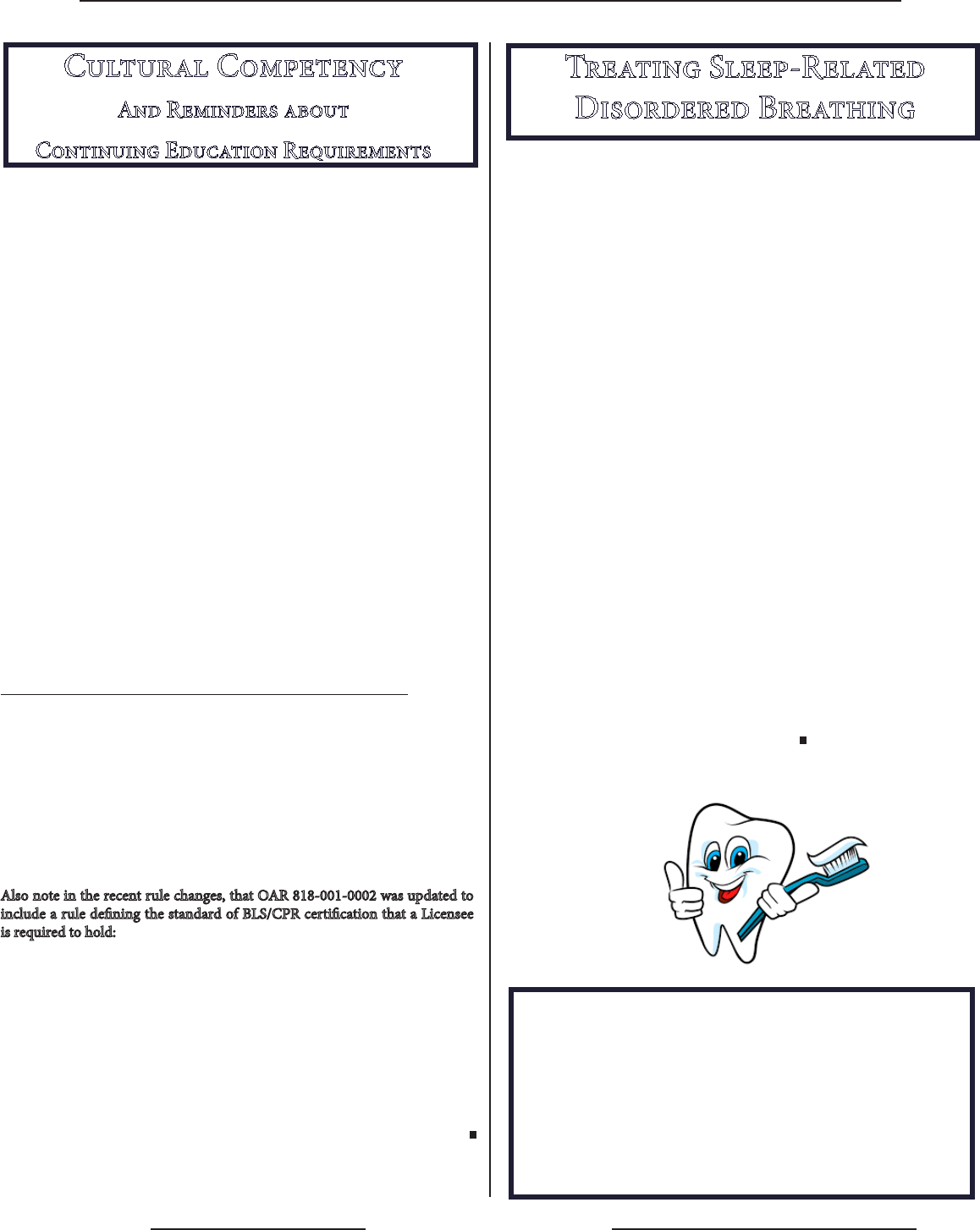
OREGON BOARD OF DENTISTRY
December 2019
www.oregon.gov/dentistry
5
C C
A
C E
W
hile reviewing the recent rule changes, you may have noticed that ef-
fective January 1, 2021, you must incorporate two (2) hours of Cultural
Competency CE into your existing continuing education requirements. is
means licensees who renew their licenses starting in 2021 must complete this
requirement prior to their expiration date. However, licensees do not need to
wait until 2021 to take this type of course for it to count towards their continu-
ing education. Lastly, please note that these two hours are not in addition to the
24, 36 or 40 hours of CE required for the renewal of a license, but are calculated
within those hours.
So the rst question you might have is, “what is cultural competency?” e
Oregon Health Authority (OHA) and the Oregon Board of Dentistry dene
cultural competency continuing education as:
“Cultural competency continuing education is a life-long process of examin-
ing values and beliefs while developing and applying an inclusive approach to
health care practice in a manner that recognizes the context and complexities
of provider-patient interactions and preserves the dignity of individuals, fam-
ilies and communities. Continuing education in cultural competency should
teach attitudes, knowledge and skills to care eectively for patients from di-
verse cultures, groups and communities.”
You may have additional questions, such as, “why is this required?” And, “how
do I meet this requirement?” e 2019 Legislative session yielded HB 2011,
which directs most health regulatory licensing boards to require their licensees
to complete this type of CE. e OBD supports the legislation, and is here to
help you meet this requirement. e OHA is regularly updating their website
https://www.oregon.gov/oha/OEI/Pages/CCCE-HB2611-2013.aspx to assist
you in taking classes on this subject. You also may fulll the CE requirement
outside of the OHA. No one is bound to using the OHA for this type of CE.
e OBD has generally given its licensees wide latitude to complete any and all
continuing education requirements. You may take classes online (except initial
Healthcare Provider BLS/CPR Certication), use free providers and can always
check with us before taking the class to see if it meets our criteria and rules. We
audit approximately 15% of all licensees each renewal cycle, and those involved
in disciplinary matters are checked for compliance as well.
Also note in the recent rule changes, that OAR 818-001-0002 was updated to
include a rule dening the standard of BLS/CPR certication that a Licensee
is required to hold:
(17) “BLS for Healthcare Providers or its Equivalent” the CPR certication
standard is the American Heart Association’s BLS Healthcare Providers Course
or its equivalent, as determined by the Board. is initial CPR course must
be a hands-on course; online CPR courses will not be approved by the Board
for initial CPR certication: Aer the initial CPR certication, the Board will
accept a Board-approved BLS for Healthcare Providers or its equivalent Online
Renewal course for license renewal. A CPR certication card with an expira-
tion date must be received from the CPR provider as documentation of CPR
certication. e Board considers the CPR expiration date to be the last day
of the month that the CPR instructor indicates that the certication expires.”
T S-
D B
A
s more and more dentists are treating Sleep-Related Disordered Breathing
(SRDB), the Board is starting to see an increase in the number of com-
plaints related to dentists treating Obstructive Sleep Apnea (OSA) and SRDB.
Dentists can (and do) play an essential role in the multidisciplinary care of
patients with certain sleep related breathing disorders, and are well-positioned
to identify patients at greater risk of SRDB and OSA. Since sleep-related disor-
dered breathing can be caused by a number of multifactorial medical issues, a
physician’s diagnoses of SRDB (based on a patient’s medical history, symptoms
from a medical evaluation, and ndings from either polysomnography or a
home sleep apnea test) is necessary before a dentist can treat the SRDB.
Oral Appliance erapy (OAT) can improve OSA in adult patients, especially
those who are intolerant of Continuous Positive Airway Pressure (CPAP), and
dentists are the only health care provider with the knowledge and expertise to
provide OAT. Working in conjunction with physicians, dentists can help treat
these disorders.
Dentists have long been aware of the importance of the maintenance of their
patient’s airway. Many dentists and their hygienists regularly screen their pa-
tient’s Mallampati score, and grade their patient’s tonsils to evaluate a patient’s
airway. But again, dentists may not diagnose SRDB and sleep apnea; a physi-
cian must make the diagnosis and then prescribe oral appliance therapy before
the dentist can treat it.
In children, a dentist can and should refer the patient to a pediatric otolaryn-
gologist for evaluation and treatment of suspected airway obstruction caused
by hypertrophic tonsils.
It is the Board’s position that the diagnosis of SRDB or OSA is outside the
scope of the practice of dentistry, and the diagnosis must be made by a physi-
cian prior to oral appliance therapy by a dentist.
DID YOU NOW?
In addition to reporting child abuse, pursuant to OS 124.050,
as of January 1, 2015, dentists are also required to report elder
abuse.
To report child or elder abuse, you may contact your local
Department of Human Services (DHS) oce, or you may also
call the DHS toll-free hotline at
1-855-503-7233
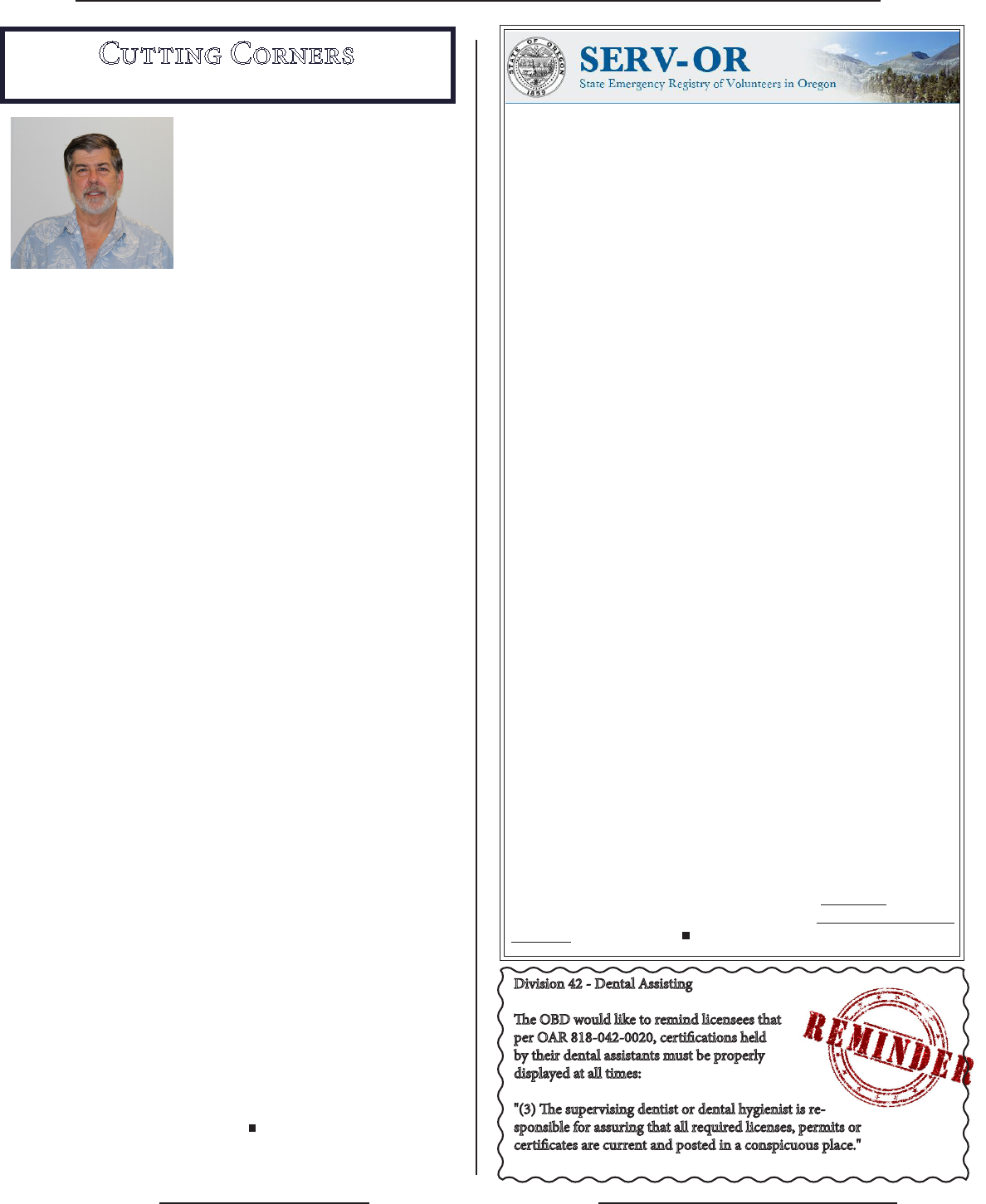
OREGON BOARD OF DENTISTRY
December 2019 www.oregon.gov/dentistry
6
C C
Daniel Blickensta, D.D.S., M.Sc.
I
f there was a recurring theme throughout
many of the Board complaints related to
dentistry, it is that the dentist had “cut a cor-
ner” somewhere during the treatment.
Take for example, the initial comprehensive
exam. ere may not have been a review of
the patient’s medical history, or periodon-
tal pocket charting documented. e ra-
diographic images may have been of poor,
non-diagnostic quality, and the dentist failed to have new radiographic
images taken.
We have also seen corners being cut during treatment planning. ere
have been a number of implants placed with little to no thought as to how
the implant was going to be restored, or no diagnostic models were made.
A treatment plan for upper anterior crowns/veneers may have been made
without a diagnostic wax-up, which would allow the patient to see what
the nished product would look like. Before beginning restorative treat-
ment, the dentist should ask themselves: “Is the periodontium sound?” “Is
there enough bone for an implant?” “Is there enough boney support for
the tooth to support a xed bridge?” “Are corners getting cut so that the
restorative portion of the treatment plan can be charged out?”
In some complaints, we found that the patient’s treatment consultation
had been glossed over - especially the part regarding fees, and when they
needed to be paid. Many Board complaints stem from the fact that the
dentist had their front oce sta handle a patient’s concerns, rather than
speaking with the patient themselves. Ultimately, it is a better use of the
dentist’s time to answer a patient’s questions and concerns directly, than to
have the patient complain to the Board to try to resolve the issue.
Failure to stop and take a nal root canal lm to verify that the ll is ac-
ceptable before inserting a post or preparing the tooth for a crown, or not
taking a radiographic image to verify that the transfer-coping is fully seat-
ed before taking a nal impression, are further examples of corner-cutting
that the Board sees on a regular basis.
Additionally, don’t cut corners when it comes to documentation. Spend
time adequately documenting in the patient records the treatment that
was provided, and any conversations that you had with the patient. Good
documentation is the most successful defense in many Board complaints.
Insucient time to accomplish these goals seems to be related to the un-
derlying goal of increasing oce productivity. A lot more money can be
produced if a crown prep is completed in an hour, than if an evaluation
is completed in an hour. us, the goal of maximizing productivity in the
short-term contributes to “cutting corners.”
Cutting corners results in poor communication between dentists and pa-
tients, insucient or no informed consent, having to re-do work if the
therapeutic outcome was not the desired or anticipated outcome, and
unnecessary complaints being generated to the Board of Dentistry. e
highest quality of dental care should be the goal for all patients. Obvi-
ously, specic circumstances for each patient may result in a “Plan B”, or
“Plan C” option being accepted and executed. e “Plan A” option should
always be presented to the patient rst.
T
he State Emergency Registry of Volunteers in Oregon (SERV-OR) is
putting out a call to dental professionals to recruit, train, and deploy
dentists, dental hygienists and dental assistants during public health emer-
gencies in Oregon. e SERV-OR program is continually working to pro-
mote engagement across healthcare professions in our ongoing eorts to be
prepared to protect the health and safety of Oregonians during large-scale
disasters. If you’ve ever thought about volunteering your time, energy, and
invaluable medical skills to a worthwhile and potentially life-saving cause,
the registry, and your fellow Oregonians, could use you.
Of the 3,000 medical volunteers currently registered with SERV-OR state-
wide, only 47 work in the dental industry. ough SERV-OR already con-
sists of a strong cadre of engaged volunteers in various professions, it is
evident that there is a true need for additional dental professionals.
As a member of SERV-OR, you will be registered, trained, and contacted
in the event of an emergency. As with any volunteer program, your par-
ticipation in any one event is entirely voluntary. Duties of volunteers can
vary widely depending on the type and magnitude of the crisis. You may be
asked to sta a Federal Medical Station, help maintain a sterile healthcare
environment, operate an emergency hotline providing information to the
public within the scope of your expertise, or respond in the community to
urgent wellness needs following a public health crisis such as an outbreak
or other interruption that may cause a lapse in regular services. ese,
among many other tasks, are essential to maintaining or restoring the pub-
lic’s health during or following an emergency.
During non-emergency times, SERV-OR volunteers may participate in free
disaster-related trainings alongside like-minded professionals. ese train-
ings are designed to enhance individual preparedness, as well as coordi-
nation and familiarity with fellow volunteers and other emergency service
agencies.
For those licensed medical professionals that qualify to be SERV-OR mem-
bers, including previously licensed professionals who have retired fewer
than 10 years’ prior, tort and workers’ compensation liability coverage is
oered by the state of Oregon when participating in a state sanctioned de-
ployment.
As a volunteer, you’ll gain personal satisfaction, a chance to make a dier-
ence in your community, and the knowledge that you are part of an eec-
tive, ocial response system.
For more information about SERV-OR, please visit serv-or.org, or contact
the volunteer coordinator, Sophie Miller-DeSart, at Sophie.Miller-DeSart@
state.or.us or 971-291-2033.
Division 42 - Dental Assisting
e OBD would like to remind licensees that
per OAR 818-042-0020, certications held
by their dental assistants must be properly
displayed at all times:
"(3) e supervising dentist or dental hygienist is re-
sponsible for assuring that all required licenses, permits or
certicates are current and posted in a conspicuous place."
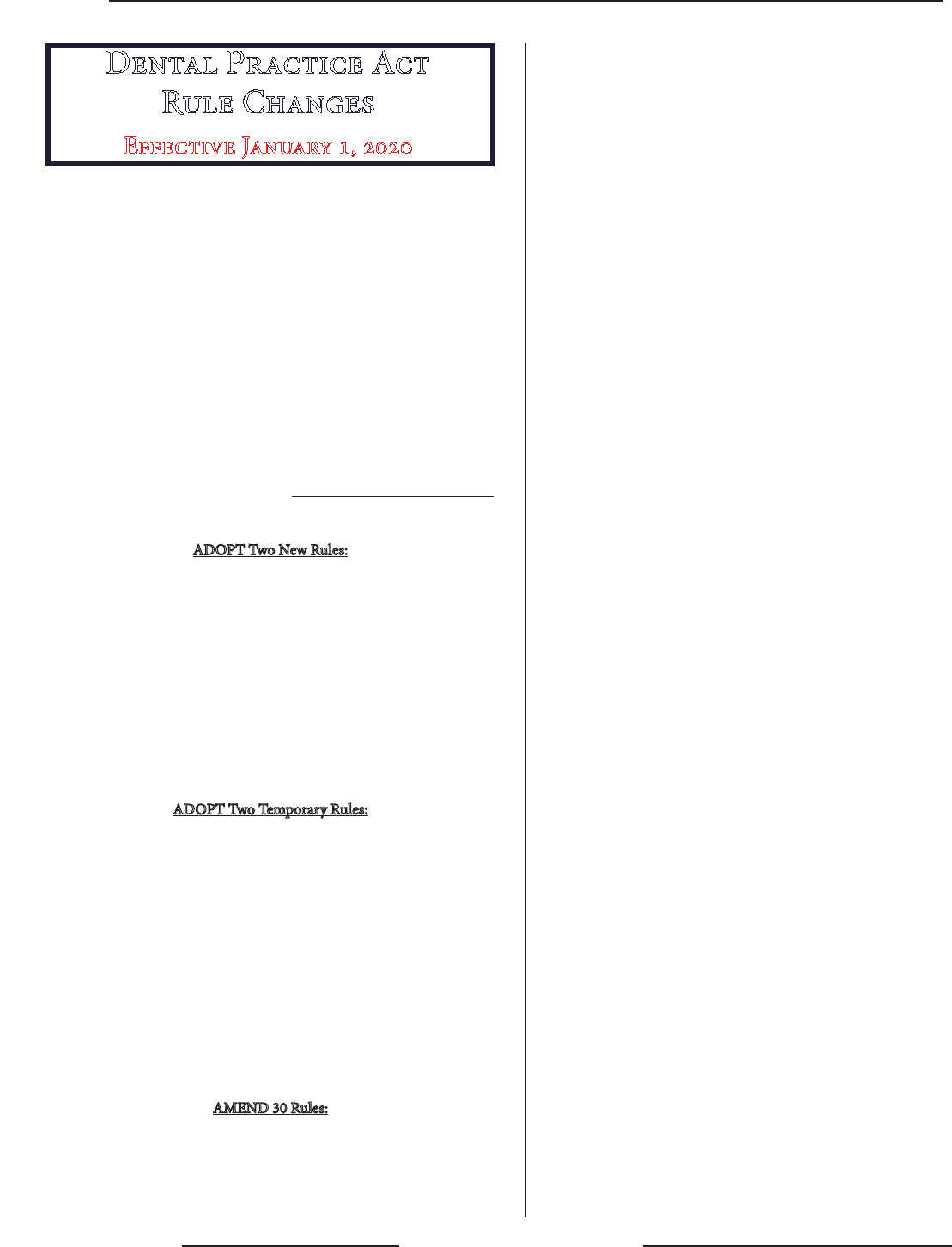
OREGON BOARD OF DENTISTRY
December 2019
www.oregon.gov/dentistry
T
he Oregon Board of Dentistry and other state agencies operate under
a system of administrative rules to ensure fairness and consistency
in procedures and decisions. Periodically, these Oregon Administrative
Rules (OARs) must be adopted, amended or repealed. OARs are writ-
ten within the agency’s statutory authority granted by the Legislature.
e Board held two public rulemaking hearings on September 17 and
October 11, along with accepting public comment on the proposed rule
changes from late August until October 11, 2019.
At the October 25, 2019 Board meeting, the Board adopted two (2) new
vaccine rules, two (2) temporary rules and amended 30 other rules. ese
34 rule changes are eective January 1, 2020.
Ocial Notice of rulemaking is provided in the Oregon Secretary of
State’s Bulletin. Due to space constraints in this newsletter, a brief sum-
mary of the 34 rule changes is provided. e full text of the OARs and
all rules can be found at our website http://www.oregon.gov/dentistry
(Look under the Hot Topics Tab)
ADOPT Two New Rules:
ADOPT: 818-012-0006
RULE TITLE: Qualications - Administration of Vaccines
RULE SUMMARY: Due to the passage of HB 2220 (2019), dentists are
allowed to prescribe and administer vaccines aer meeting certain train-
ing requirements and criteria.
ADOPT: 818-012-0007
RULE TITLE: Procedures, Record Keeping and Reporting
RULE SUMMARY: Due to the passage of HB 2220 (2019), dentists are
allowed to prescribe and administer vaccines aer meeting certain train-
ing requirements and criteria.
ADOPT Two Temporary Rules:
ADOPT: 818-021-0018
RULE TITLE: Temporary Dental License for Spouses or Domestic
Partners of Active Duty Armed Forces of the United States Stationed in
Oregon
RULE SUMMARY: e passage of SB 688 and HB 3030 (2019) require
the Board to create new rules for temporary licenses.
ADOPT: 818-021-0019
RULE TITLE: Temporary Dental Hygiene License for Spouses or
Domestic Partners of Active Duty Armed Forces of the United States
Stationed in Oregon
RULE SUMMARY: e passage of SB 688 and HB 3030 (2019) require
the Board to create new rules for temporary licenses.
AMEND 30 Rules:
AMEND: 818-001-0002
RULE TITLE: Denitions
RULE SUMMARY: Dental anesthesiology is being added as a new dental
specialty area, and standard for BLS for Healthcare Provider is claried.
AMEND: 818-012-0005
RULE TITLE: Scope of Practice
RULE SUMMARY: A word was misspelled and is being corrected.
AMEND: 818-012-0030
RULE TITLE: Unprofessional Conduct
RULE SUMMARY: e rule change species that certain dentists are
required to register with the Prescription Drug Monitoring Program
(PDMP).
AMEND: 818-012-0070
RULE TITLE: Patient Records
RULE SUMMARY: e rule change requires that the patient records
be legible, and adds requirements for documentation when placing
implants.
AMEND: 818-015-0007
RULE TITLE: Specialty Advertising
RULE SUMMARY: Dental Anesthesiology has been added as a Board
recognized dental specialty.
AMEND: 818-021-0010
RULE TITLE: Application for License to Practice Dentistry
RULE SUMMARY: Due to the passage of SB 824 (2019), the Board is
expanding recognition of testing agencies for meeting requirements of
licensure.
AMEND: 818-021-0011
RULE TITLE: Application for License to Practice Dentistry Without Fur-
ther Examination
RULE SUMMARY: Due to the passage of SB 824 (2019), the Board is
expanding recognition of testing agencies for meeting licensure require-
ments.
AMEND: 818-021-0012
RULE TITLE: Specialties Recognized
RULE SUMMARY: Dental Anesthesiology is being added to the dental
specialties that may advertise as a specialist.
AMEND: 818-021-0017
RULE TITLE: Application to Practice as a Specialist
RULE SUMMARY: e Board is allowing clinical practice hours spent
teaching to be recognized as part of the criteria to be licensed as a spe-
cialist.
AMEND: 818-021-0020
RULE TITLE: Application for License to Practice Dental Hygiene
RULE SUMMARY: Due to the passage of SB 824 (2019), the Board is
expanding recognition of testing agencies for meeting licensure require-
ments.
AMEND: 818-021-0025
RULE TITLE: Application for License to Practice Dental Hygiene With-
out Further Examination
RULE SUMMARY: Due to the passage of SB 824 (2019), the Board is
expanding recognition of testing agencies for meeting requirements of
licensure.
AMEND: 818-021-0060
RULE TITLE: Continuing Education — Dentists
RULE SUMMARY: Due to the passage of HB 2011 (2019), the Board
will require two hours of continuing education on the topic of cultural
competency eective January 1, 2021.
D P A
C
E J ,
7
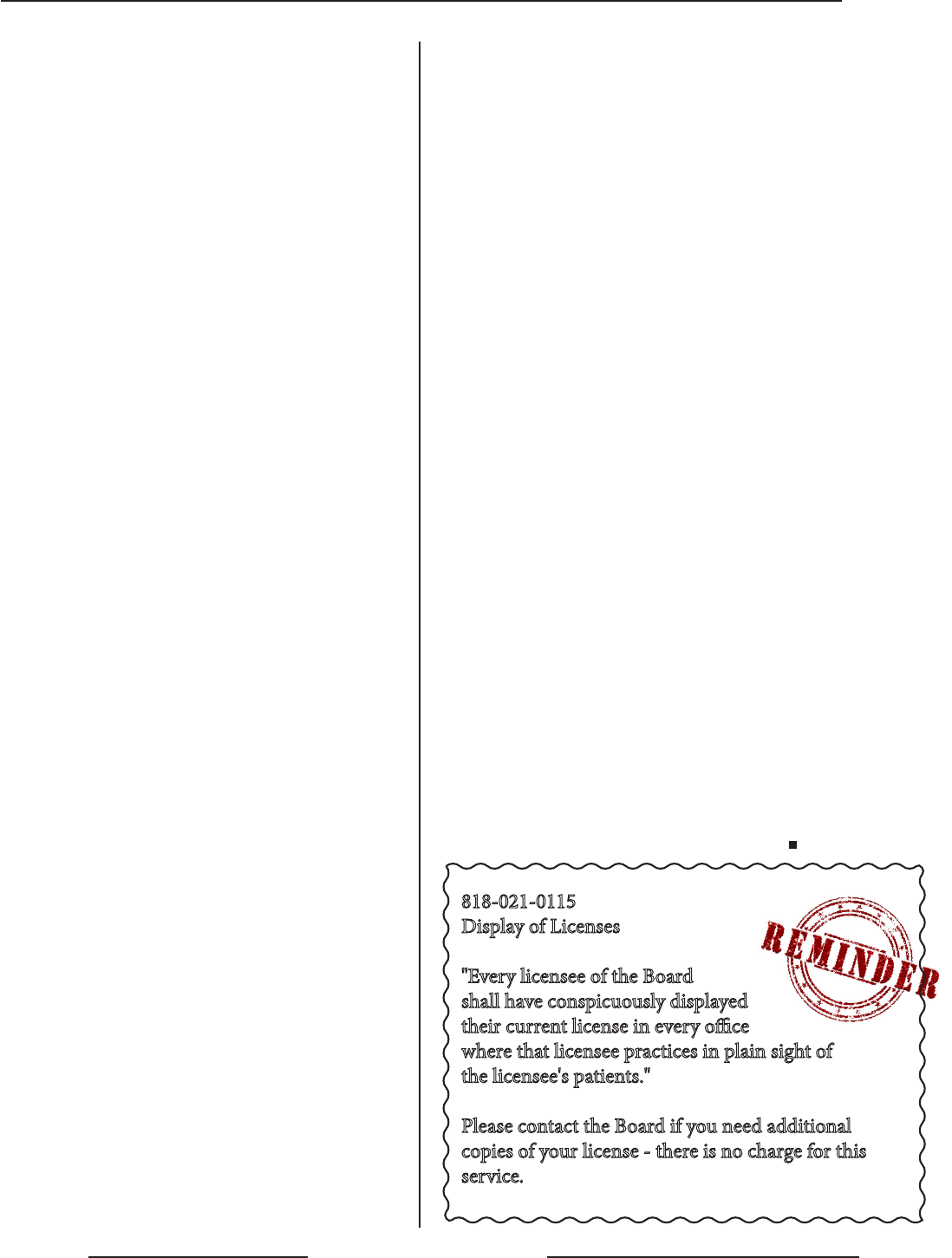
OREGON BOARD OF DENTISTRY
December 2019 www.oregon.gov/dentistry
AMEND: 818-042-0040
RULE TITLE: Prohibited Acts
RULE SUMMARY: e rule change has added other dental assistant
certications referenced and renumbered it.
AMEND: 818-042-0050
RULE TITLE: Taking of X-Rays — Exposing of Radiographic Images
RULE SUMMARY: e rule change updates language regarding radio-
graphs.
AMEND: 818-042-0070
RULE TITLE: Expanded Function Dental Assistants (EFDA)
RULE SUMMARY: e rule change updates language in reference to
dentures and deletes reference to teeth whitening procedures.
AMEND: 818-042-0080
RULE TITLE: Certication — Expanded Function Dental Assistant
(EFDA)
RULE SUMMARY: e number of procedures has been reduced
throughout the rule making it easier to certify dental assistants as EF-
DAs.
AMEND: 818-042-0095
RULE TITLE: Restorative Functions of Dental Assistants
RULE SUMMARY: Duplicative language has been removed in the title,
with no change to the rule itself.
AMEND: 818-042-0110
RULE TITLE: Certication — Expanded Function Orthodontic Assis-
tant (EFODA)
RULE SUMMARY: e rule change expands the options for the criteria
for the EFODA certication.
AMEND: 818-042-0113
RULE TITLE: Certication – Expanded Function Preventive Dental
Assistants (EFPDA)
RULE SUMMARY: e rule change expands the options for the criteria
for the EFPDA certication.
AMEND: 818-042-0116
RULE TITLE: Certication – Anesthesia Dental Assistant
RULE SUMMARY: e rule change recognizes other options to be certi-
ed as an anesthesia dental assistant.
AMEND: 818-021-0070
RULE TITLE: Continuing Education — Dental Hygienists
RULE SUMMARY: Due to the passage of HB 2011 (2019), the
Board will require two hours of continuing education on the topic
of cultural competency eective January 1, 2021.
AMEND: 818-021-0088
RULE TITLE: Volunteer License
RULE SUMMARY: e rule change revises hourly volunteer re-
quirements to coincide with a two-year licensure period.
AMEND: 818-026-0030
RULE TITLE: Requirements for Anesthesia Permits
RULE SUMMARY: e rule change removes some duplicative
language, and moved the reference to anesthesia monitors to each
individual anesthesia permit rule, to help licensees understand the
criteria needed for anesthesia monitors.
AMEND: 818-026-0040
RULE TITLE: Qualications, Standards Applicable, and Continuing
Education Requirements for Anesthesia Permits: Nitrous Oxide
Permit
RULE SUMMARY: e reference to anesthesia monitors is being
moved to each individual anesthesia permit rule, to help licensees
understand the criteria needed for anesthesia monitors.
AMEND: 818-026-0050
RULE TITLE: Minimal Sedation Permit
RULE SUMMARY: e rule change claries what records and medi-
cations must be documented and also adds the anesthesia monitor
criteria.
AMEND: 818-026-0055
RULE TITLE: Dental Hygiene and Dental Assistant Procedures
Performed Under Nitrous Oxide or Minimal Sedation
RULE SUMMARY: e rule change claries that indirect supervi-
sion is acceptable for dental assistants completing duties referenced
in rule.
AMEND: 818-026-0060
RULE TITLE: Moderate Sedation Permit
RULE SUMMARY: e reference to anesthesia monitors has been
moved to each individual anesthesia permit rule, to help licensees
understand the criteria needed for anesthesia monitors.
AMEND: 818-026-0065
RULE TITLE: Deep Sedation Permit
RULE SUMMARY: e reference to anesthesia monitors has been
moved to each individual anesthesia permit rule, to help licensees
understand the criteria needed for anesthesia monitors.
AMEND: 818-026-0070
RULE TITLE: General Anesthesia Permit
RULE SUMMARY: e reference to anesthesia monitors has been
moved to each individual anesthesia permit rule, to help licensees
understand the criteria needed for anesthesia monitors.
AMEND: 818-026-0080
RULE TITLE: Standards Applicable When a Dentist Performs Den-
tal Procedures, and a Qualied Provider Induces Anesthesia
RULE SUMMARY: e rule change has claried the criteria for
monitoring, sedating and discharging patients, and the records
required.
8
818-021-0115
Display of Licenses
"Every licensee of the Board
shall have conspicuously displayed
their current license in every oce
where that licensee practices in plain sight of
the licensee's patients."
Please contact the Board if you need additional
copies of your license - there is no charge for this
service.

OREGON BOARD OF DENTISTRY
December 2019
www.oregon.gov/dentistry
9
e OBD has a new website (www.oregon.gov/dentistry), and a new web-
page titled “Hot Topics”. e OBD keeps this page updated with current
topics including the most recent rule changes.
Dental Hygienists –
Silver Nitrate and
Silver Diamine Fluoride
Dental hygienists in the
State of Oregon can ad-
minister and dispense sil-
ver diamine uoride and
silver nitrate. Silver nitrate
is considered an antimi-
crobial agent. Pursuant to
OAR 818-035-0030(1)(e)
a dental hygienist can “Ad-
minister and dispense anti-
microbial solutions or other
antimicrobial agents in the
performance of dental hy-
giene functions”.
Prescription Drug Monitoring Program (PDMP)
In February 2018, legislation was passed along with rules enacted by the Oregon Health
Authority requiring all dentists with an active Drug Enforcement Administration (DEA)
registration to register with the PDMP.
HbA1c Testing
At its Board Meeting on December 14, 2018, the Board
of Dentistry recognized that it is within the scope of
practice for a licensee to perform in-oce A1C diabe-
tes screening test for at-risk patients. e Board noted
that: a) such testing is not presumed to be the standard
of care; and b) for A1C screenings beyond the normal
range, licensees should refer patients to a physician for a
formal evaluation, diagnosis, and treatment.
For information regarding HbA1c testing, the American
Dental Association has published a guide to point of
care, diabetes testing and reporting:
www.oregon.gov/dentistry/Documents/ADA_Guide_
to_Point_of_Care_Diabetes_Testing_and_Reporting.
pdf
Expanded Functions Dental Assistants -
Placing Retraction Material Subgingivally
Did you know that dental assistants in Oregon who are
EFDA certied, and who have completed a Board Ap-
proved course, can place retraction material subgingivally?
In October 2015, the Oregon Board of Dentistry amended
OAR 818-042-0090 Additional Functions of EFDAs to al-
low EFDAs to place retraction material subgingivally.
818-042-0090
Additional Functions of EFDAs
Upon successful completion of a course of instruction in
a program accredited by the Commission on Dental Ac-
creditation of the American Dental Association, or other
course of instruction approved by the Board, a certied
Expanded Function Dental Assistant may perform the
following functions under the indirect supervision of a
dentist or dental hygienist providing that the procedure
is checked by the dentist or dental hygienist prior to the
patient being dismissed:
(1) Apply pit and ssure sealants provided the patient is
examined before the sealants are placed. e sealants must
be placed within 45 days of the procedure being autho-
rized by a dentist or dental hygienist.
(2) Apply temporary so relines to complete dentures for
the purpose of tissue conditioning.
(3) Place retraction material subgingivally.
If you are interested in your EFDA being able to place re-
traction material subgingivally, below is the URL to access
application forms to become an instructor, as well as a list
of instructors who are already approved:
www.oregon.gov/dentistry/Pages/dental-assistants.aspx
Cultural Competence Continuing Education
HB2011 was signed by Governor Brown on May 30, 2019. e OBD is working on draing
new rules related to continuing education which should go into eect in 2020.
e OBD considers cultural competency relevant to the current practice of all licensees,
and licensees may use this CE towards their required CE hours.
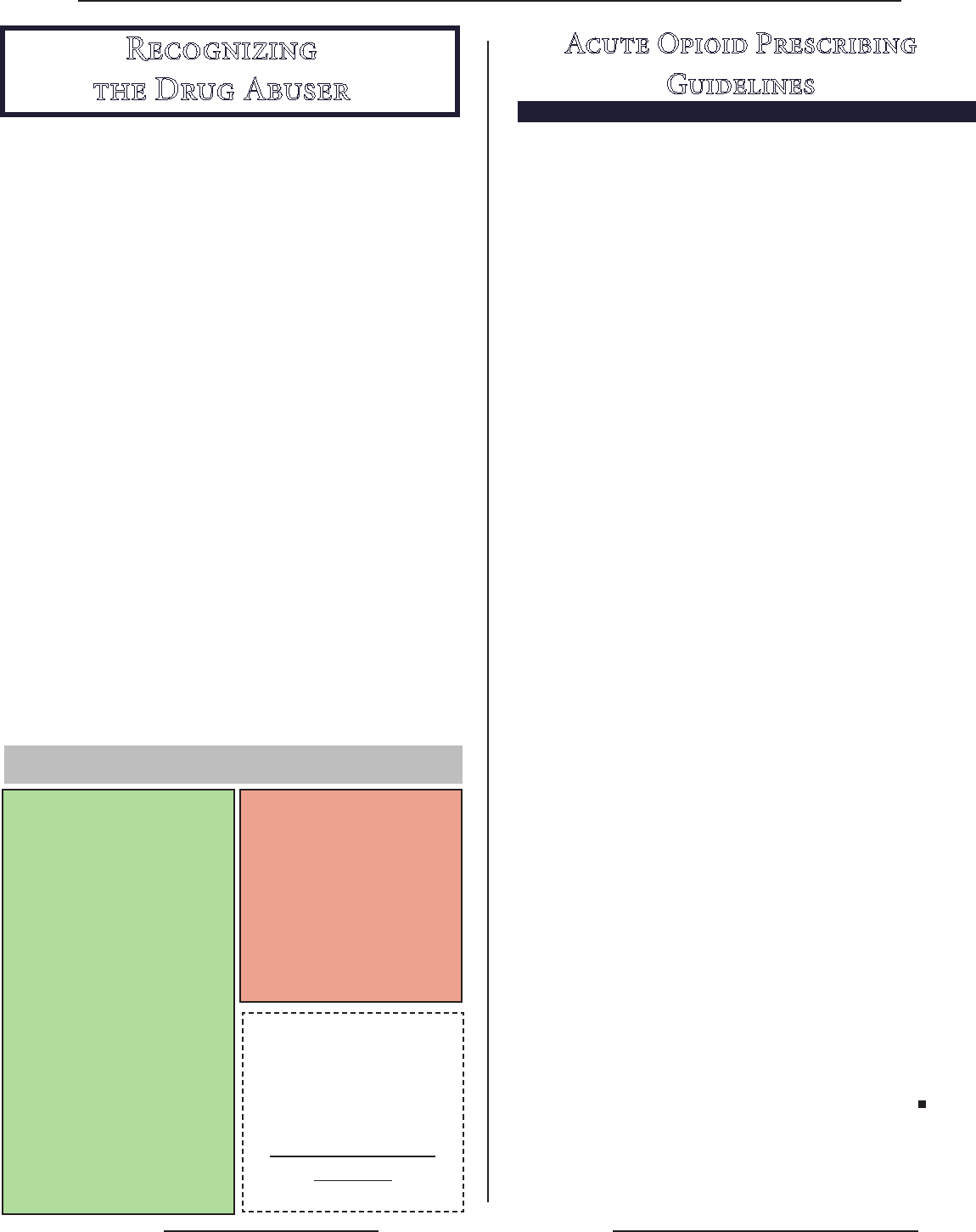
OREGON BOARD OF DENTISTRY
December 2019 www.oregon.gov/dentistry
10
D A
Modus Operandi Oen Used by the
Drug-Abusing Patient Include:
• Must be seen right away;
• Wants an appointment toward end of oce hours;
• Calls or comes in aer regular business hours;
• Traveling through town, visiting friends or relatives (not a permanent
resident);
• Feigning physical problems, such as abdominal or back pain, kidney
stone, or migraine headache in an eort to obtain narcotic drugs;
• Feigning psychological problems, such as anxiety, insomnia, fatigue or
depression in an eort to obtain stimulants or depressants;
• States that specic non-narcotic analgesics do not work or that he/she is
allergic to them;
• Contends to be a patient of a practitioner who is currently unavailable or
will not give the name of a primary or reference physician;
• States that a prescription has been lost or stolen and needs replacing;
• Deceives the practitioner, such as by requesting rells more oen than
originally prescribed;
• Pressures the practitioner by eliciting sympathy or guilt or by direct
threats; Utilizes a child or an elderly person when
seeking methylphenidate or pain medication.
What You Should Do When Confronted by a
Suspected Drug Abuser:
DO:
• Perform a thorough examination
appropriate to the condition.
• Document examination results
and questions you asked the
patient.
• Request picture I.D. or other
I.D. and Social Security number.
Photocopy these documents
and include in the patient’s record.
• Call a previous practitioner,
pharmacist or hospital to conrm
the patient’s story,
• Conrm a telephone number, if
provided by the patient.
• Conrm the current address at
each visit.
• Write prescriptions for limited
quantities.
DON’T:
• “Take their word for it” when
you are suspicious.
• Dispense drugs just to get rid of
drugseeking patients.
• Prescribe, dispense or adminis-
ter controlled substances outside
the scope of your professional
practice or in the absence of a
formal practitioner-patient rela-
tionship.
Additional information
on DEA’s Diversion
Control Program
is available at:
www.DEAdiversion.
usdoj.gov
T
he Oregon Health Authority released the Oregon Acute Opioid Prescrib-
ing Guidelines, in an eort to help clinicians working in surgical, dental,
primary care, emergency and urgent care settings make evidence-based pre-
scribing decisions when treating pain.
Opioid painkillers are powerful medications that come with risks. While
they’re eective in treating acute, non-cancer pain, high doses and long-
term use could lead to dependence, abuse, overdose and death. In Oregon,
ve people per week die of opioid related overdoses.
e guidelines, developed in consensus with our Board, and external work-
group representing public health, health care and coordinated care orga-
nization leaders, build on Oregon prescribing guidelines for chronic pain,
published in 2016. e acute prescribing guidelines focus on acute pain
management for patients who are new to opioids. ey are not intended
for those who currently receive opioids, nor for those with a history of sub-
stance use disorder. e guidelines could also help prevent patients with
acute pain from becoming dependent on opioids long term. According to a
2017 analysis by the Centers for Disease Control and Prevention, 30 percent
of those who receive an initial 30-day prescription of opioid painkillers re-
mained on opioids a year later.
Common examples of relevant clinical situations include: wisdom teeth ex-
tractions, sports injuries and post-surgical pain management. It is common
practice for patients to be prescribed 30-day prescriptions in these settings.
e new guidelines advise that the lowest eective dose of short-acting opi-
oids be prescribed for no more than three days in most cases.
"While opioids are eective medications in acute pain management, many
people do not use all of the pills that are prescribed by their doctors aer an
acute event," said Katrina Hedberg, MD, state health ocer at OHA. "What
this tells us is that patients may not need as many pills as we think, and other
forms of pain management may be safer and just as eective. It also tells us
that there are many excess pills sitting in medicine cabinets, which could be
misused or stolen."
In general, the guidelines advise against using opioids as the rst-line ther-
apy for mild to moderate pain. If opioids are deemed appropriate and likely
eective for the patient, the guidelines emphasize the following principles:
• Evaluate the patient.
• Assess history of long-term opioid use or substance use disorder.
• Check the Prescription Drug Monitoring Program, which tracks pre-
scribed controlled substances such as opioids and benzodiazepines.
• Provide patient education.
• Prescribe the lowest eective dose of short-acting opioids for no more than
three days in most cases and no more than seven days in cases of more se-
vere acute pain.
• Provide follow-up and reassess pain, healing and function.
• Implement, monitor and document pain management practices to ensure
care, safety, and quality.
e full guidelines can be found on the OBD’s & OHA’s websites.
A O P
G
e Oregon Health Authority
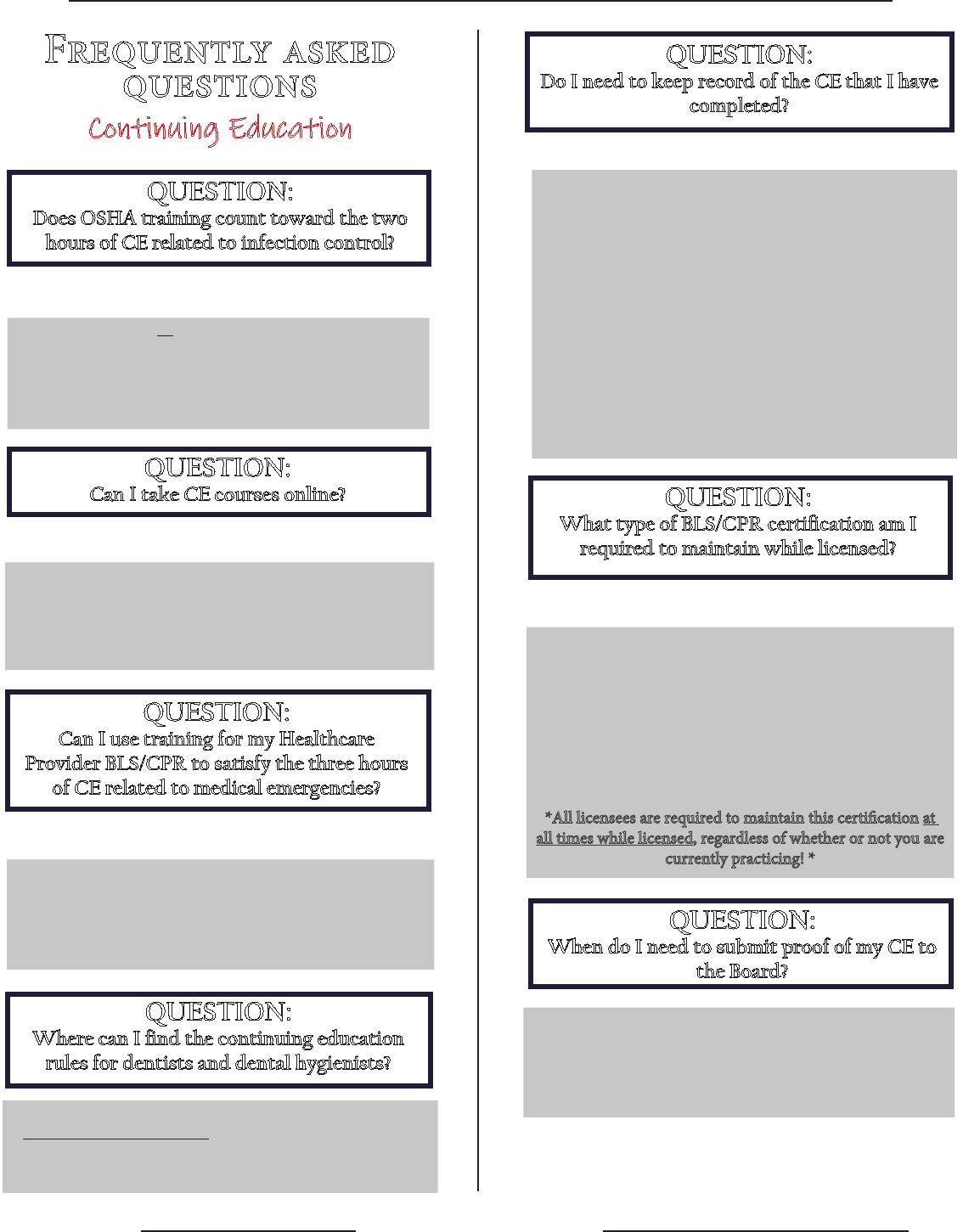
OREGON BOARD OF DENTISTRY
December 2019 www.oregon.gov/dentistry
11
F
Continuing Education
QUESTION:
Does OSHA training count toward the two
hours of CE related to infection control?
Answer: It Depends!
The answer is “yes” IF the OSHA course has instruction in
infection control. Please note that your course completion
certicate would need to delineate how many hours were
devoted to OSHA instruction and how many hours were
devoted to infection control.
QUESTION:
Can I take CE courses online?
Answer: Yes!
According to OAR 818-021-0060 (3)(c) and OAR 818-021-
0070 (3)(c), continuing education includes correspondence
courses, videotapes, distance learning courses or similar self-
study course, provided that the course includes an examina-
tion and the licensee passes the examination.
QUESTION:
Can I use training for my Healthcare
Provider BLS/CPR to satisfy the three hours
of CE related to medical emergencies?
Answer: Yes!
Training taken to maintain current Healthcare Provider BLS/
CPR certication, or its equivalent can be used towards the
three hours of CE related to medical emergencies. It may not
be counted toward CE required to maintain nitrous oxide or
minimal sedation permits.
QUESTION:
Do I need to keep record of the CE that I have
completed?
Answer: Yes!
According to OAR 818-021-0060 (2) and OAR 818-021-0070
(2), Dentists must maintain records of successful comple-
tion of continuing education for at least four licensure years
consistent with the licensee’s licensure cycle. (A licensure
year for dentists is April 1 through March 31.) The licensee,
upon request by the Board, shall provide proof of successful
completion of continuing education courses.
Dental hygienists must maintain records of successful
completion of continuing education for at least four licen-
sure years consistent with the licensee’s licensure cycle. (A
licensure year for dental hygienists is October 1 through
September 30.) The licensee, upon request by the Board, shall
provide proof of successful completion of continuing educa-
tion courses.
QUESTION:
What type of BLS/CPR certication am I
required to maintain while licensed?
QUESTION:
Where can I nd the continuing education
rules for dentists and dental hygienists?
Answer: Healthcare Provider Level
e CPR certication standard is the American Heart Asso-
ciation’s BLS Healthcare Providers Course or its equivalent, as
determined by the Board. is initial CPR course must be a
hands-on course; online CPR courses will not be approved by
the Board for initial CPR certication: Aer the initial CPR
certication, the Board will accept a Board-approved BLS for
Healthcare Providers or its equivalent Online Renewal course
for license renewal.
*All licensees are required to maintain this certication at
all times while licensed, regardless of whether or not you are
currently practicing! *
The rules are listed on our website at
www.oregon.gov/dentistry. They can also be found in the
Dental Practice Act under Division 21 - Examination and
Licensing: OAR 818-021-0060 and OAR 818-021-0070.
QUESTION:
When do I need to submit proof of my CE to
the Board?
Licensees are required to submit proof of CE upon request of
the Board or Board staff. The Board audits approximately 15%
of licensees' CE during each renewal cycle. Additionally, you
may be asked to provide proof of your CE in the event that a
complaint is led against you.
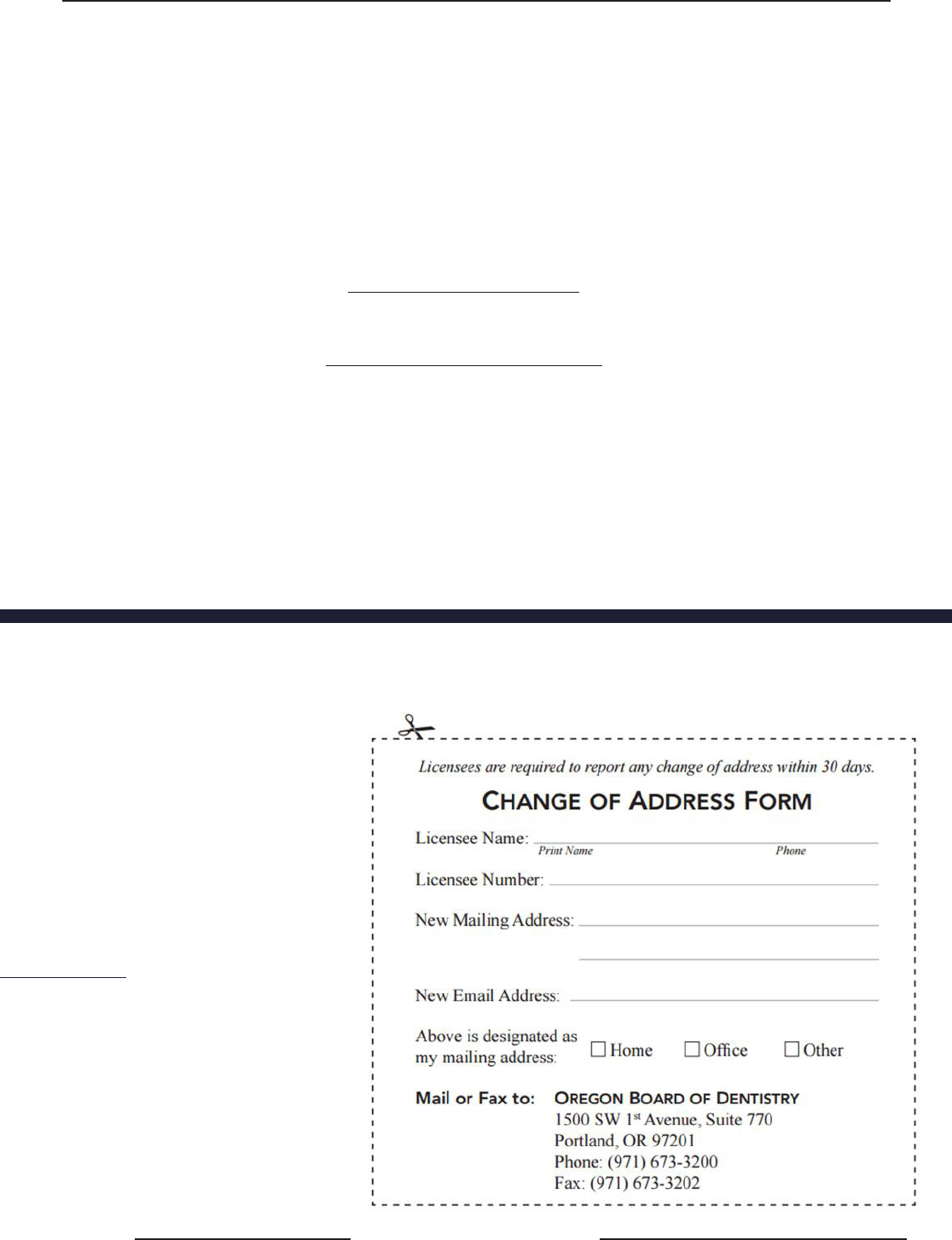
OREGON BOARD OF DENTISTRY
December 2019
www.oregon.gov/dentistry
IT'S THE LAW!
You must notify the OBD within
30 days of any change of address.
An online Update Contact Info
form is on the OBD's website at
www.oregon.gov/dentistry. All
address changes must be made
in writing, by fax, mail, or email.
Our Mission: e mission of the
Oregon Board of Dentistry is to
promote high quality oral health
care in the State of Oregon by
equitably regulating dental
professionals.
12
OREGON BOARD OF DENTISTRY
1500 SW 1ST AVENUE, SUITE #770
PORTLAND, OR 97201
Phone: 971-673-3200
Fax: 971-673-3202
Www. Oregon.gov/dentistry
Email:
Information@oregondentistry.org
